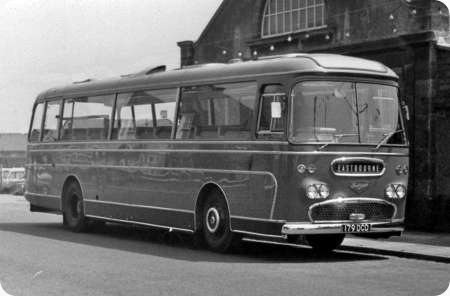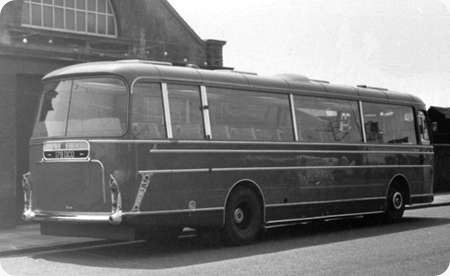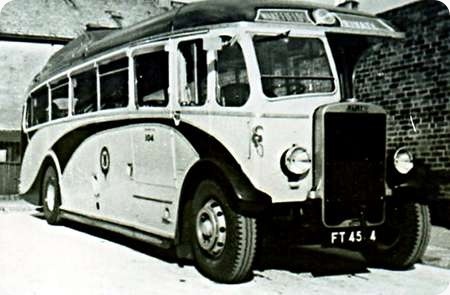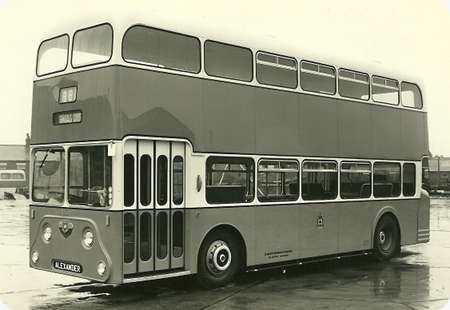
Glasgow Corporation
1958
Leyland Atlantean PDR1/1
Alexander H44/34F
The picture, which appears to be a pre delivery shot, shows Leyland Atlantean PDR1/1, LA1 delivered to Glasgow Corporation Transport in 1958. It was registered FYS 998 and had an Alexander H44/34F body.
The Alexander body was described at the time as ‘boxy’ and remained the only body of this style with Glasgow. Alexander and GCT worked together after this, to design a more rounded and pleasing body to a new "Glasgow Style" a design which won favour from other Bus operators, around the UK.
LA1 was allocated to Ibrox Garage where it spent the majority of its time in service.
The legal lettering shows the General Manager to be Mr. E.R.L. Fitzpayne. He became Manager in 1943 after being Assistant Manager, and remained in post until 1969 when he retired.
LA1 is now in preservation.
Photograph and Copy contributed by Stephen Howarth
14/11/13 – 06:00
Newcastle Corporation had quite a number of very similar vehicles, although the front panel was different and theirs had twin headlights. The first 14 came in 1961 the fleet numbers were the same as the registration, and they were 187 – 189/201 JVK (188 had a Metro Cammell body) then 11 more in 1961, 214/224 JVK. 221 is alive and well and part of the N.E.B.P.T. Ltd collection and can be seen on their site. However, they weren’t the first Alexander bodied Atlanteans in the area, the NGT group took delivery of 15 in 1960, KCN 181/9 were for Gateshead and 601/7 EUP went to Sunderland District. Again the body had a different front panel, and the top two thirds of the drivers windscreen was swept back.
Ronnie Hoye
14/11/13 – 06:00
Sheffield 369 was a one off identical Atlantean, shoved onto the end of Sheffield’s small initial batch of 1959 Met Camm Atlanteans and before a further short batch of Met Camms. 20 Alexander Regent Vs followed a year later in 1960. It would be 1972 until the next Alexander deckers arrived – on Fleetline chassis – although some Y type Leopards snuck in in 1968. This would be the beginning of a long love affair between STD and then SYPTE and Alexanders – ending only when First Group took over control of Mainline. [Continuing their historic practise of dual sourcing, during the Alexander years this would be East Lancs – including Dennis Dominators to SYPTE style which even closer to R types than the usual run of Alexander East Lancs clones.
David Oldfield
14/11/13 – 06:00
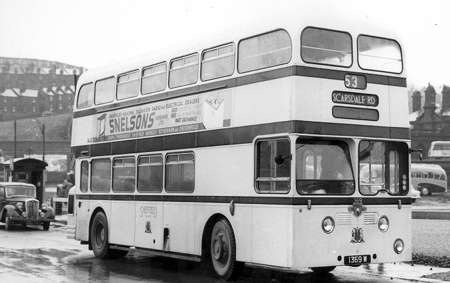
It would appear that Sheffield Corporation was somewhat unimpressed by the Glasgow Style as No. 369 was the only Alexander Atlantean bought in this design in 1960. It was to be some twelve years before Sheffield called upon Alexander for bodies on rear engined Daimler and Atlantean chassis.
John Darwent
14/11/13 – 09:44
When the new Riverside Museum Opened at Glasgow there was no room for this bus or the BUT/Burlingham Trolleybus. I do not think the new museum is a patch on the previous Kelvin Hall Collection. There is not as much room as there was but at least some of the trams are shown.
Philip Carlton
14/11/13 – 13:40
I rode on Sheffield 369 on the Outer Circle and wondered why there was odd Alexander-bodied one. I seem to recall it had an odd destination layout at the back.
Glasgow LA1 competes with Wallasey 1 and James of Ammanford 227 for the distinction of being the first production Atlantean – all are shown as entering service in 12/58. No doubt it depends on definitions. We can safely say that LA1 was the first in Scotland!
Geoff Kerr
14/11/13 – 16:50
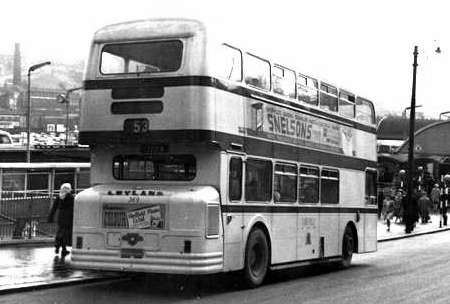
Your memory serves you well Geoff. 369 had a full Sheffield set on the rear albeit downside up so to speak.
John Darwent
14/11/13 – 17:42
Funny how we remember these details for 45 years. Lucky you photographed the rear, John, as not many did!
Geoff Kerr
14/11/13 – 17:42
The strange thing is that it looks like no other Alexander body before or since. Godfrey Abbott also had a couple – but I cannot remember whether they were bought new or second hand.
David Oldfield
14/11/13 – 17:58
According to The Leyland Bus The first four production chassis were as follows:
The Wallasey chassis was the first numerically, followed by one for Maidstone and District, then the Glasgow vehicle and finally the one for James of Ammanford. However the Glasgow chassis left the works for the body builders a day before the others and was eventually the first into service after appearing at the 1958 Commercial Show.
Phil Blinkhorn
15/11/13 – 06:28
Re Sheffield 369 – I don’t recall short workings on the 53 to Scarsdale Road, I suppose it would be the bus replacement equivalent of the Woodbank Crescent short workings of the trams. How did the buses turn at Scarsdale Road?
Ian Wild
15/11/13 – 06:29
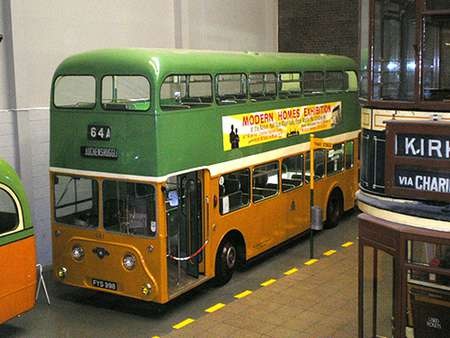
Glasgow LA1 in the Glasgow Transport Museum
Stephen Howarth
15/11/13 – 08:31
The original colour scheme on the Glasgow Atlantean was much more balanced than its final scheme. Regarding the Sheffield indicator layout, referring again to The Leyland Bus, there is a rear view of Sheffield 922, one of the second batch with MCW bodies, which shows a two panel rectangular destination and via display, one above the other, set to the nearside and a small rectangular service number panel set to the offside and placed on a level so the centre of that panel was level with the gap between the two larger panels – a much neater and, I seem to recall, standard layout.
Phil Blinkhorn
15/11/13 – 08:31
Easy, Ian. Turn right at lights, left at Dale/Woodseats Road and left again at top of Woodseats Road – where 75/76 already emerged to turn right to go to Meadowhead, Norton or Bradway. I have never seen a short to Scarsdale either, but it was a timing point – and an annoying one. As a student, I would often arrive in Sheffield at 2020 off the X48 18:30 ex Manchester LMS – in the days when the 42/53 was OMO to Lowedges Road with 33’0" PDR2/1 Park Royals. One-manning was time expensive during the day but at night with few, if any passengers, these magnificent machines could shift and easily get ahead of themselves. A ten minute stop, when I wanted to get home, was not an uncommon occurrence. [Of course, intelligent scheduling could have overcome this.]
David Oldfield
16/11/13 – 08:47
Phil, Sheffield 916-932 of 1960 were the only Atlanteans with this rear destination arrangement. The following batch 933-944 of 1962 reverted to a rear triple route number only but with main and via blinds side by side above the forward lower saloon windows. The displays at the rear of 916 etc quickly fell into disuse (as did those on 369) and the destination glasses were soon panelled over. Thanks David for Scarsdale Road shorts turning – I was confusing Scarsdale Road and Derbyshire Lane.
Ian Wild
16/11/13 – 11:30
If memory serves, a foolish thing to do at my age, the early Newcastle Atlanteans had a rear destination blind, and the bonnet had a drop down step to gain access to the handle to change it, as you can imagine this was highly popular, and more often than not the blind remained blank. I seem to think that the rear number plate was moved to that spot, which tended to make it look disproportionately large.
Ronnie Hoye
17/11/13 – 06:54
Ronnie, thank you for your fascinating commentary about the early Newcastle Atlanteans. I believe that 187 and 188 were delivered in 1960 and these were followed in 1961 by a batch of 25 with bodywork split between Alexander (13) and Weymann (12). I had long been puzzled by the abnormally large rear registration plates on Atlanteans 189-238 and your memory has solved something that had me puzzled for the best part of 48 years. Well, I never!
I would add that Belfast Corporation took an early Atlantean with this style of Alexander bodywork, number 551 registered 5540 XI.
Kevin Hey
17/11/13 – 09:44

Ronnie, the drop down step was a standard feature on early Atlanteans. It was a metal plate and can be clearly seen in the picture of Sheffield 369 above interrupting the topmost of the three mouldings at the bottom of the engine compartment, just below the Atlantean badge.
Phil Blinkhorn
17/11/13 – 14:09
I remember these "footplates" they were often left down. Was it customary then to ride on them thus leading to their demise?
Joe
18/11/13 – 16:43
At first sighting, I thought the batch of Sheffield Atlanteans 915-932 were quite something, with that full set of destination blinds at the rear they really stood out. When new they were put on the 17 between Dobcroft Road at Millhouses and Sheffield Lane Top, which route passed the end of my grandmother’s road, and that high pitched sound they made, rather reminiscent of a giant vacuum cleaner I always thought, was unmistakeable as I listened for them making their way along Owler Lane until late at night. They had that distinctive pitching and yawing motion down pat too, as they pulled into the stops, which was ironically not unlike the trams that had run along the same stretch of roadway just a year or so before.
Dave Careless
19/11/13 – 05:45
Re my comments on the 16th, Sheffield 916-932 were not the only Atlanteans with rear destinations and route numbers. I’d forgotten the 1962 JOC deliveries had this arrangement as well, 1350-1358 (B fleet) and 1163-1165 (C fleet). It was the 1962 A fleet 933-944 which eliminated the rear destinations leaving route numbers only.
Ian Wild
19/11/13 – 08:22
Thanks Ian, I thought there had been more with that indicator layout than in your original post as they stuck in my mind from my visits across the Pennines in the 1960s.
Phil Blinkhorn
19/11/13 – 12:06
I’m fairly sure the 1959 batches of Atlanteans, 363 – 8 and 881 – 899 (xxx WJ) just had a route number box at the rear. Funny how we’ve ended up in Sheffield again, after starting in Glasgow!
Geoff Kerr
19/11/13 – 13:58
Geoff, you are quite correct – as is Ian that the last full blind rears were on the 1962 B and C fleet Atlanteans. The A fleets (as well as the first Fleetlines 951-953) reverted to number only displays.
David Oldfield
20/11/13 – 05:40
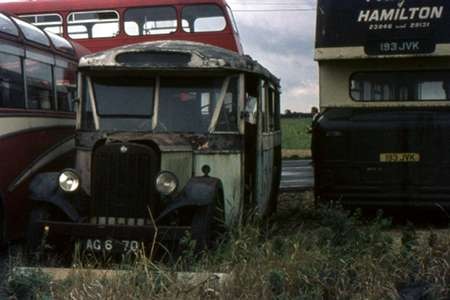
Whilst looking through some old slides a couple of days ago, I came across this shot of the rear of ex Newcastle Atlantean 193JVK which illustrates Ronnie’s comment about the oversized space occupied by the registration number. Not sure who added the reflective number plate though! No drop down step though. The photograph was taken in the summer of 1975, on the premises of Fowlers of Holbeach Drove the bus was in the livery of Parks of Hamilton, presumably newly acquired by Fowler.
The REO also in the picture, AG 6470, has I think, since been restored.
Bob Gell
20/11/13 – 06:47
…..but remember, Bob, that early Atlantean engine cowls were notoriously fragile. They were a complete unit and very prone to damage – needing replacement. 193 JVK possibly had just such a replacement. [On later Atlanteans only the middle section raised – and the ends swung out.]
David Oldfield
20/11/13 – 09:27
Have to say, in retrospect, apart from the unfortunate sad look at the front, it’s not a bad looking bus. Bit of a pity they didn’t follow through and improve on this rather than what they did. I quite liked the look of the AL with peaks (STD) and the R type, though quality was a little suspect on the latter. [Never came across an R type that wasn’t swimming in water on the floor during and after a rainfall.]
David Oldfield
20/11/13 – 11:19
David, I have to agree with your comments re LA1. I well remember seeing my first Atlantean in Stoke on Trent a week or so after the first deliveries. Apart from the shock of the new, in the context of the time, both the MCW and Alexander offerings were reasonably good looking. Where I disagree is about what followed. Whilst the Alexander balloon roof did not suit all the body styles (front engined vehicles looking the worst), the Glasgow examples were OK but the lowbridge version looked very stylish and avant garde, especially compared to everything else that was around at the time. In my area, North Western’s examples put everything else in the shade from the moment they appeared, and that included the Renowns which were delivered at the same time.
On another topic, didn’t Leyland change the engine shroud after the introduction of the Fleetline which had a hinged bonnet section as opposed to the cowl having to be removed as a whole, Daimler having learned from the problems the original Atlantean shroud was causing.
Regarding Geoff Kerr’s comment about Sheffield I think that Mr Oldfield is here under an alias. His real name is Forcefield. His love of all things Sheffield reminds me of a great friend of mine, one time Tourism and Conference Officer for Sheffield, Keith Cheetham, who would and could turn any conversation to Sheffield "The City in the Golden Frame". David has a similar influence which he manages to project through the electronic media and this site is all the better for it!
Phil Blinkhorn
20/11/13 – 12:04
How kind (I think) Mr Blinkhorn.
David Oldfield
20/11/13 – 13:51
Comment was made with the best of intentions David.
Phil Blinkhorn
20/11/13 – 13:52
Again, from memory, I seem to think that by the time they were withdrawn from service, none of Newcastles Atlanteans still had a one piece bonnet, and they had all been replaced by the type mentioned by David.
Ronnie Hoye
20/11/13 – 15:49
I know it was, Phil…..
David Oldfield
20/11/13 – 16:37
David, your comments relating to the Atlantean one-piece engine cowl are interesting, as Bristol also opted for a one-piece job when it introduced the VRT. Just as on the early Atlanteans, the original VRT cowls were somewhat flimsy affairs, and were similarly prone to damage. The cowl was hinged under the rear lower deck window and was fastened at the sides by Triumph Herald-type bonnet catches. Unfortunately the catches didn’t always fasten as they should, sometimes leading to sides ‘flapping’ and cracking. A more sensible three-piece design soon replaced the original thank goodness, but considering how long the Atlantean had been in production before the VRT came along, it’s somewhat surprising that Bristol hadn’t learned from the problems encountered earlier by Leyland.
Brendan Smith
21/11/13 – 05:45
The mention of ‘being able to turn all things to Sheffield’ made me wonder if I had put the wrong picture on here?
Stephen Howarth
21/11/13 – 05:45
A bit of the classic "not invented here" syndrome !
Stephen Ford
28/09/16 – 07:00
First saw LA1 at a motor show in Kelvin Hall in the 1950s. Became bus driver in 1965 at 21 and worked at Parkhead garage where I drove LA1 often. It was the only LA with the split screen as all others had full screen at least up to 1969 when I left.
James Dearie
 Vehicle reminder shot for this posting
Vehicle reminder shot for this posting
22/10/18 – 06:00
The Glasgow LA1 is based at the Glasgow Vintage Vehicle Museum (Open day Oct 18) and they have just produced a book on the Glasgow Transport’s love of the Atlanteans which are 60 this year
James
